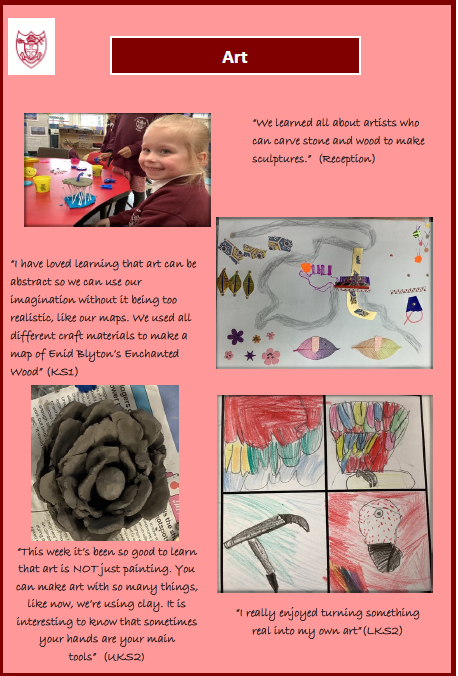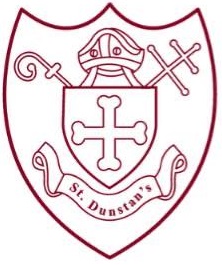Art and Design
Intent
At St Dunstan’s, we want our children to be inspired and confident when exploring and inventing their own works of art. Following the Kapow scheme, we deliver lessons designed to give pupils every opportunity to develop their abilities, nurture their talents and interests, express ideas, and truly appreciate art across cultures and history.
Children will encounter fun and engaging ways to learn the skills of drawing, painting, mixed media, sculpture, 3D work, craft, and design. Teachers at St Dunstan’s encourage children to take risks, experiment and reflect, creating opportunities to see, think, and do everything as individuals. It is extremely important that in a school that prides itself on inclusivity, art lessons are fairly liberal and uplifting, opening up possibilities for every child to discover themselves.
Matched with our school’s term Building the Kingdom theme, our lessons are sequenced to link learning to other curriculum areas and provide opportunities for deep and meaningful teaching sessions. All learning sequences identify key knowledge that will be assessed against progression markers for each year group, ensuring children advance in art as they move through our school. In line with our school’s vision statement, our children can continue on a lifelong learning journey.
Implementation
Our long-term plan has been developed using the Kapow Art progression and is linked to other themes throughout our school. The units are flexible enough to encompass teachers’ own creativity and be adapted to form strong links with other areas of our curriculum. Art is taught in blocks, giving teachers and children time and frequency of lessons to embed key skills and knowledge.
Formal art elements, such as drawing and painting, are taught from Early Years Foundation Stage and revisited each year with increasing complexity. This is one of our school’s strategies to allow children to revise and build on their previous learning, developing the child’s long-term memory.
The scheme of work used is designed with four strands that run throughout. These are:
- Generating ideas
- Skills (line, shape, tone, texture, pattern and colour)
- Knowledge of artists
- Evaluating and analysing
Children document their practice, analysis and reflections in an individual sketchbook carried with them through their time at St Dunstan’s, honouring their creativity and success with every school year. We observe a no-marking policy for these sketchbooks, allowing the children to be their own assessors – encouraging more freedom of expression and subjectivity. Where necessary, children embark upon a group or paired projects, too, as a way of collaborating on their learned skills, ideas and backgrounds. Our Progression of skills and knowledge shows the skills taught within each year group and how these skills develop to ensure that attainment targets are securely met by the end of each key stage.
Differentiated guidance is available for every lesson so that all can be accessed and enjoyed by all pupils in our school. There are also knowledge organisers built for each unit to support the delivery of key vocabulary, techniques and knowledge to encourage a specific use of language in teaching and, successively, suitable recall.
Impact
Pupils at St Dunstan’s enjoy, value and look forward to art. They appreciate the importance of art in the context of personal well-being, history and creative and cultural industries – recognising its many career possibilities. Our children’s work is celebrated through class and school displays, allowing all to share and appreciate their progress.
Our art curriculum contributes to the children’s personal development in creativity, independence, judgement and self-reflection, enhancing their confidence in talking about their work, sharing it and owning it.
A child’s progress will be shown through outcomes from each unit and tracked using our Progression and Knowledge tracking tool, which embeds the four key strands (generating ideas, skills, knowledge of artists, evaluating and analysing) as children move through our school.

